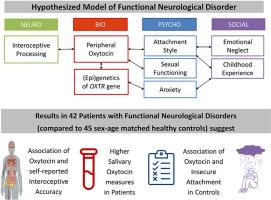Increased salivary oxytocin correlates with lower self-reported interoceptive accuracy in functional neurological disorders
IF 3.6
2区 医学
Q1 NEUROSCIENCES
引用次数: 0
Abstract
Introduction
Functional Neurological Disorder (FND) is shaped by psychosocial stress, early adversity, and neuroendocrine dysregulation. Oxytocin (OXT), a hormone central to stress regulation and interoception, remains largely unexplored in FND.
Methods
In this cross-sectional study, salivary OXT was assessed at four timepoints across 87 participants (42 FND and 45 sex-age-matched healthy controls), including appetite and satiety and hormonal factors (intake of hormonal contraception or menstrual cycle phases) as covariates. Self-reported interoception, attachment style, childhood trauma and sexual functioning were assessed allowing analysis for association.
Results
Patients with FND exhibited higher OXT concentrations (averaged across four timepoints: d = 0.55, p = 0.031), which remained when controlling for covariates. Appetite and satiety specifically modulated OXT levels at different timepoints, underlying the group difference after lunch (p = 0.006) and at the end of the study visit (p = 0.035). Self-reported interoceptive accuracy was negatively correlated with OXT (r = −0.31, p = 0.014) and insecure attachment was positively correlated with OXT in controls (r = 0.42, p = 0.005), but not in FND. No associations of OXT and childhood trauma or sexual functioning reports were found.
Discussion
The elevated salivary OXT levels observed in patients with FND may reflect a dysregulated or compensatory neuroendocrine response. The combination of higher OXT and lower self-reported interoceptive accuracy suggests that OXT may be upregulated as an attempt to modulate bodily stress or restore homeostatic balance. The absent association of OXT with attachment style in FND specifically supports its role in dealing with socio-affiliative stress.

在功能性神经疾病中,唾液催产素增加与自我报告的内感受准确性降低相关
功能性神经障碍(FND)是由社会心理压力、早期逆境和神经内分泌失调形成的。催产素(OXT)是一种应激调节和内感受的核心激素,在FND中仍未得到充分研究。在这项横断面研究中,87名参与者(42名FND和45名性别年龄匹配的健康对照)的唾液OXT在四个时间点进行评估,包括食欲和饱腹感以及激素因素(激素避孕药的摄入或月经周期阶段)作为协变量。对自我报告的内感受、依恋类型、童年创伤和性功能进行了评估,以便进行关联分析。结果FND患者表现出较高的OXT浓度(四个时间点的平均值:d = 0.55, p = 0.031),在控制协变量后仍然存在。食欲和饱腹感在不同时间点特异性地调节了OXT水平,这是午餐后(p = 0.006)和研究访问结束时(p = 0.035)的组差异的基础。自我报告的内感受准确性与OXT呈负相关(r = - 0.31, p = 0.014),不安全依恋与对照组的OXT呈正相关(r = 0.42, p = 0.005),但在FND中没有。没有发现OXT与儿童创伤或性功能报告的关联。FND患者唾液OXT水平升高可能反映了失调或代偿性神经内分泌反应。较高的OXT和较低的自我报告的内感受准确性的结合表明,OXT可能作为调节身体压力或恢复内稳态平衡的一种尝试而上调。在FND中,情感行为与依恋类型之间不存在关联,这特别支持了情感行为在处理社会附属压力中的作用。
本文章由计算机程序翻译,如有差异,请以英文原文为准。
求助全文
约1分钟内获得全文
求助全文
来源期刊

Neurobiology of Stress
Biochemistry, Genetics and Molecular Biology-Biochemistry
CiteScore
9.40
自引率
4.00%
发文量
74
审稿时长
48 days
期刊介绍:
Neurobiology of Stress is a multidisciplinary journal for the publication of original research and review articles on basic, translational and clinical research into stress and related disorders. It will focus on the impact of stress on the brain from cellular to behavioral functions and stress-related neuropsychiatric disorders (such as depression, trauma and anxiety). The translation of basic research findings into real-world applications will be a key aim of the journal.
Basic, translational and clinical research on the following topics as they relate to stress will be covered:
Molecular substrates and cell signaling,
Genetics and epigenetics,
Stress circuitry,
Structural and physiological plasticity,
Developmental Aspects,
Laboratory models of stress,
Neuroinflammation and pathology,
Memory and Cognition,
Motivational Processes,
Fear and Anxiety,
Stress-related neuropsychiatric disorders (including depression, PTSD, substance abuse),
Neuropsychopharmacology.
 求助内容:
求助内容: 应助结果提醒方式:
应助结果提醒方式:


